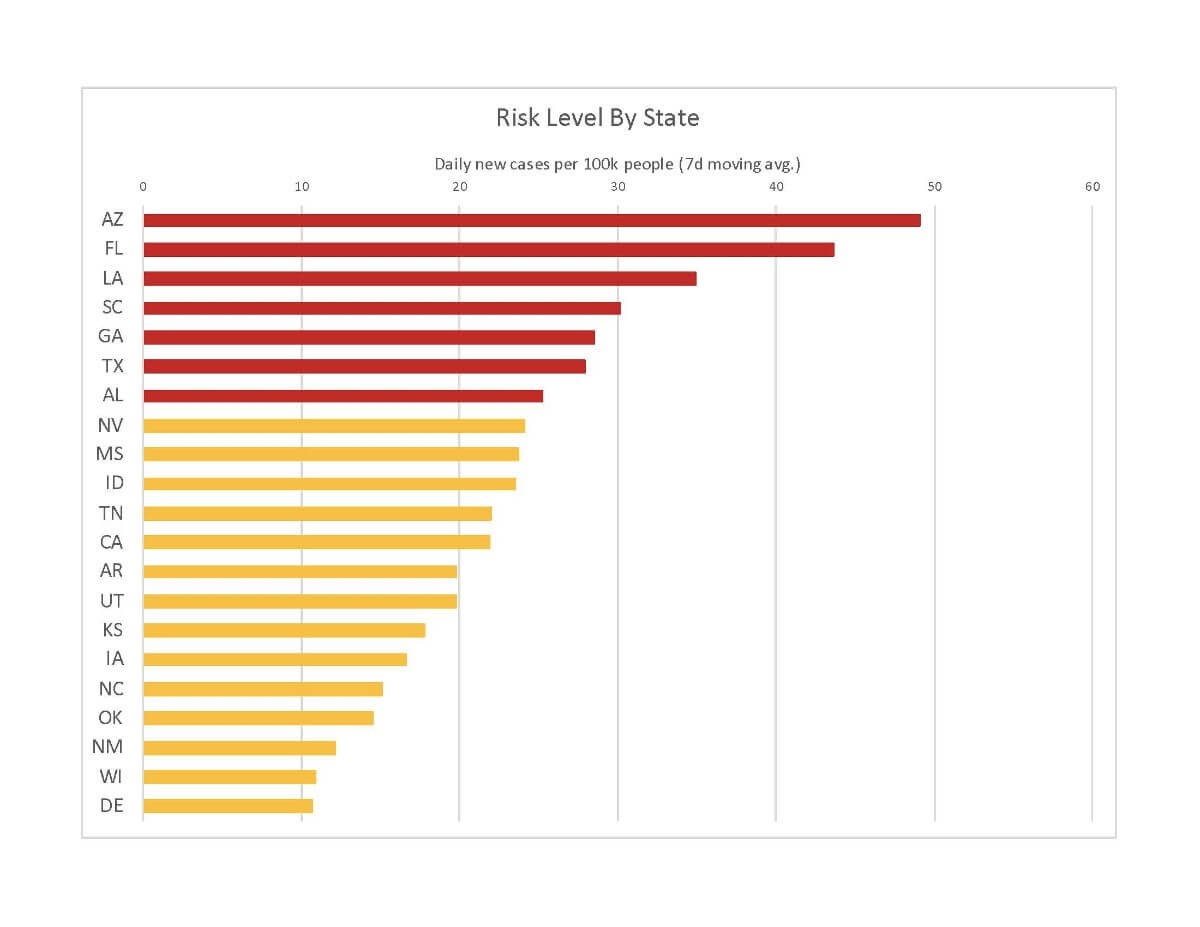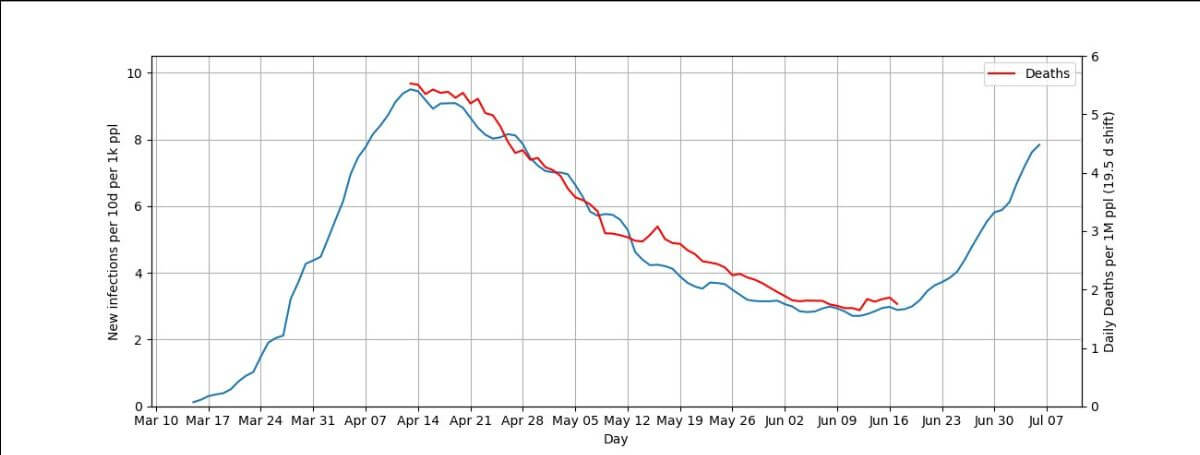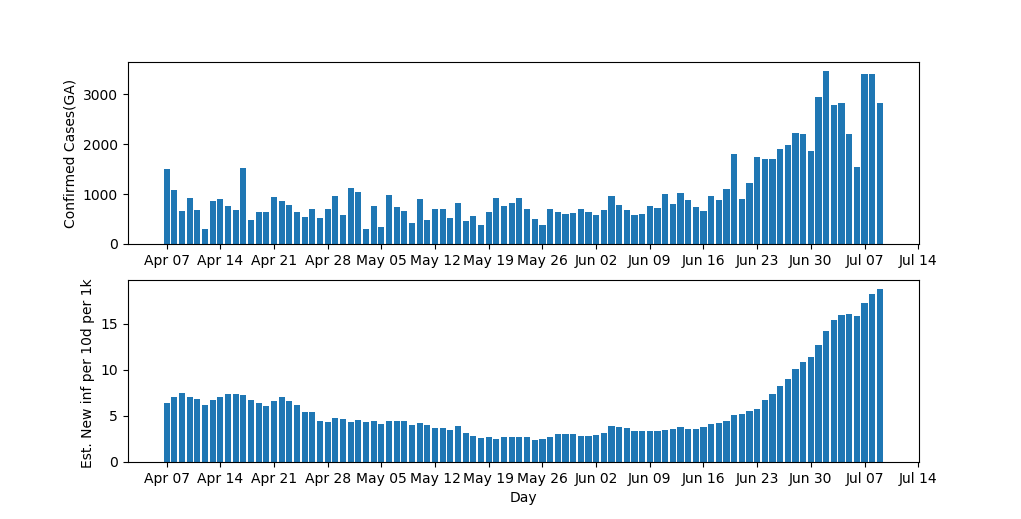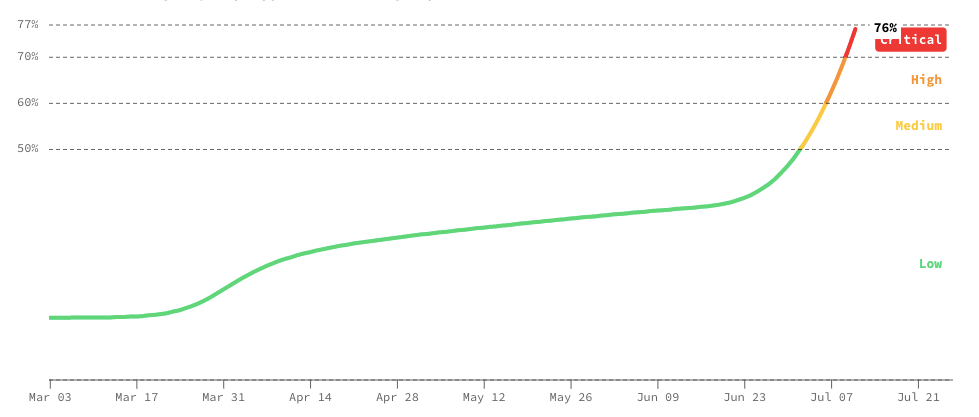Looking at the increase in cases during the last two weeks, I decided to dig into the numbers a little more, and here is what I have found.
The strategy, if there is one, is not working. Below is a chart showing the intensity in the worst 21 states determined by the 7-day moving average of daily cases per 100,000. The original chart and a county chart is available here. Those states that opened up early before they should have if they had followed CDC guidelines are performing worse than the rest.

Red: Tipping Point – Stay at Home
Orange: Accelerated Spread – Stay at Home Orders and/or Rigorous Test and Trace Programs advised.
Source: Harvard Global Health Institute
The strategy of protecting the elderly and allowing younger people to mix is also failing. Analysis by the Wall Street Journal shows, “Facilities in the Houston and Tampa metropolitan areas marked a nearly 800% cumulative increase in new cases among residents from the last week of May through the week ended June 28, the most recent period available, with more than 400 new cases during that period in both cities.” Thus these “walls” are too porous.
With the increases in cases in Florida, Texas, Georgia, Arizona, et al., testing facilities are getting backed up, resulting in longer lags between testing and getting results, allowing more people to get infected.
While deaths have not increased at the rate seen in the Northeast during the initial outbreak, many put that down to better treatment and remedies, but death rates are rising. A forboding chart, showing deaths and infections with a 19.5-day shift, produced by Dr. Blake. If this relationship holds, expect the average daily death rate to increase by 150% in the next few weeks.

Blue Line: New infections per 10 days per 1k ppl
Red Line: Daily Deaths per 1MM ppl with a 19.5-day shift.
Source Dr. Blake
As we struggle to fight COVID, lobbyists are once more wining the game. As The Washington Post points out, Emergent has received $628MM to develop manufacture a vaccine. Emergent is now the only maker of multiple drugs the government deems crucial for the Strategic National Stockpile, and the government is the company’s primary customer, accounting for most of its revenue. However, solely relying on Emergent creates:
- lack of price competition;
- risk of a single point of failure in the delivery of drugs; and
- creating a company that is too important to fail.
Reading the article, Emergent appears to overcharge the government. However, with 40 lobbyists and having spent over $40MM since going public, the payoff has been great – $20Bn in profits.
As I have said before, the market cannot solve public health crises because the incentives are misaligned. I doubt that much will change in DC, so expect more waste of government funds and increased profits for certain companies without any actual impact on the disease.
Returning to our current battle and bringing it a little closer to home, Dr. Blake provides some interesting information on Georgia’s infection density and inpatient census. At present, Georgia has 218 COVID-19 inpatients per 1M ppl. When inpatients hit 250 per 1MM ppl, expect some hospitals to start instituting elective halts.
Governor Kemp’s executive order preventing any city or county imposing a stricter lockdown than the State’s is an example of failed leadership. The virus is spreading, so some areas may need locking down while others not necessarily so. Thus his order is either too lenient or too strict depending on the situation. However, as we saw in Italy, too lenient doesn’t work for long. To paraphrase Ben Horowitz, “Leaders are there to make the unpopular decisions.” If they only implement popular decisions, no one needs them. This statement doesn’t mean that you apply those that are unpopular with your political opponents, but popular with your supporters, it means to do what is best for regardless of its popularity. Overall, Georga is is not trending well and doesn’t look good as we move towards schools opening in a few weeks.

With increasing cases, the death rate should increase; however, from the first lockdown, the issue was always overwhelming our hospital infrastructure. So what is the current situation?
According to COVID Act Now, “Georgia has about 2,833 ICU beds. Based on the best available data, we estimate that 61% (1,728) are currently occupied by non-COVID patients. Of the 1,105 ICU beds remaining, we estimate 841 are needed by COVID cases or 76% of available beds. This suggests hospitals cannot absorb a wave of new COVID infections without substantial surge capacity.”
The chart below shows Georgia’s ICU occupancy.

Critical is not where we want to be.
We already know there are ICU capacity issues in Texas, Florida, Mississippi, and Arizona., and it looks like Georiga is moving in the same direction.
Stay safe everyone, your family, friends, co-workers or employees, need you.
Recent Posts
Boosting Common Sense Decision-Making in Your Organization
Discover how to enhance decision-making in your organization by focusing on three crucial areas: solving the right problem, gathering all the available information, and understanding the intent. Learn to empower your team, foster a purpose-driven culture, and improve organizational clarity for better decision-making.
Do You Understand Your Costs to Ensure Profitability?
You can only determine profitability when you know your costs. I’ve discussed before that you should price according to value, not hours. However, you still need to know your costs to understand the minimum pricing and how it is performing. Do you consider each jobs’ profitability when you price new jobs? Do you know what you should be charging to ensure you hit your profit targets? These discussions about a company’s profitability, and what measure drives profit, are critical for your organization.
Sunk Costs Are Just That, Sunk!
If you were starting your business today, what would you do differently? This thought-provoking question is a valuable exercise, especially when it brings up the idea of “sunk costs” and how they limit us. A sunk cost is a payment or investment that has already been made. Since it is unrecoverable no matter what, a sunk cost shouldn’t be factored into any future decisions. However, we’re all familiar with the sunk cost fallacy: behavior driven by a past expenditure that isn’t recoupable, regardless of future actions.
Do You REALLY Know Your Business Model?
Bringing clarity to your organization is a common theme on The Disruption! blog. Defining your business model is a worthwhile exercise for any leadership team. But how do you even begin to bring clarity into your operations? If you’re looking for a place to start, Josh Kaufman’s “Five Parts of Every Business” offers an excellent framework. Kaufman defines five parts of every business model that all flow into the next, breaking it down into Value Creation, Marketing, Sales, Value Delivery, and Finance.
Ideation! Harder Than It Sounds
Bringing in new ideas, thoughts, understanding, and logic is key as your organization faces the challenges of a changing environment. But when you do an ideation session in your organization… how does it go? For so many organizations, many times, after a few ideas have been thrown out and rejected, the thought process slows down very quickly, and a form of hopelessness takes over. How does your organization have better ideation? I’ve come across a new approach with a few teams lately.
Recruit, Recruit, Recruit!
An uptick in business has begun this quarter, and companies are rushing to hire to meet this surge in demand. What amazes me is how many are so unprepared to hire. Continual recruiting is key to the survival of a company. It isn’t the same thing as hiring—continuous recruiting is building a pipeline of people that you would hire if you needed to fill a position, or “A players” you would hire if they were available.
We All Need Clarity
If your organization is focused on obscurity over clarity, whether intentionally or not, your “A” player employees are vulnerable. There is a looming talent crunch. As we start to emerge from COVID, demand is increasing, and many are scrambling to fill positions to meet that demand. Headhunters and recruiters are soon going to be calling your key “A” employees. Have you been giving them a reason to stay?
Not Another **** Meeting
As Leonard Bernstein put it so well, “To achieve great things, two things are needed: a plan and not quite enough time.” Your meetings can be shorter, more fruitful, and engaging, with better outcomes for the organization, employees, and managers. It’s time to examine your meeting rhythms and how you set meeting agendas. This week, I break down daily, weekly, monthly, quarterly, annual, and individual meeting rhythms, with sample agendas for each.
Is Your Company Scalable?
Let’s start here: Why should your company be scalable at all? If your business is scalable, you have business freedom–freedom with time, money, and options. Many business leaders get stuck in the “owner’s trap”, where you need to do everything yourself. Sound familiar? If you want a scalable business that gives you freedom, you need to be intentional about what you sell, and how.
Are you ready for the Talent Crunch?
Companies are gearing up to hire. Unfortunately, many are competing within the same talent pool. Some experts are currently predicting a strong economic recovery starting in May or June. But as the economy booms, there is going to be fierce competition for talent. How will you fare in the looming talent crisis? Your organization should be creating a plan, now, so you can attract the talent you need in the year ahead.










